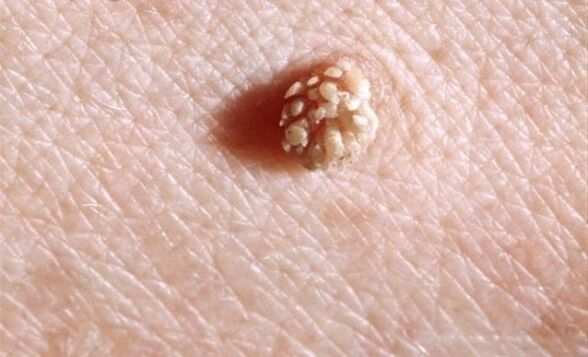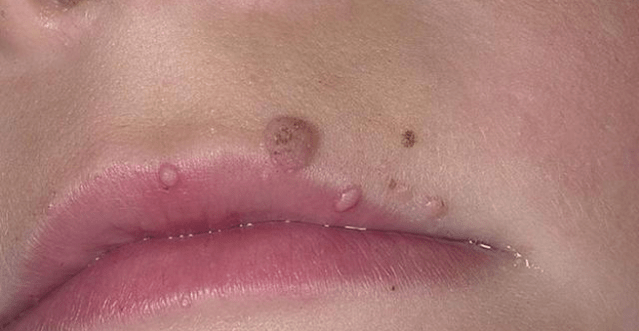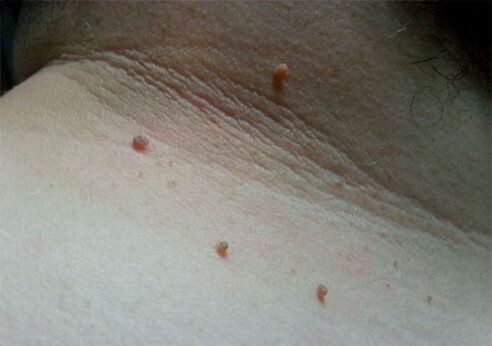
Papillomas on the body appear as a result of papillomavirus infection.By the sexual age, the human papilloma virus (HPV) can be found in most people.It is in an inactive phase.But under the influence of predisposing factors, as a result of skin damage, HPV activation occurs and characteristic papillomatous outgrowths appear.Many of them do not pose a danger and are only a cosmetic defect.But it is extremely important to determine why papillomas appear on the body and whether they are associated with the oncological process.
Some HPV strains cause malignant tissue hyperplasia.Due to the risk of growth of oncological neoplasms, regardless of the cause of the appearance of papillomas on the body, treatment is carried out mainly by surgical methods.If skin growths appear, you must first consult a dermatologist.If neoplasms are detected in the genital area - to the venereologist.The specialist can accurately determine what papillomas appear on the body and mucous membranes, set the HPV strain and determine the oncogenic risk.

What papillomas can appear on the body
Outwardly, papilloma resembles a horn outgrowth, going beyond the upper layer of the skin.The neoplasm often has a thin leg.Papillomas on the body can be single or located in groups.They resemble the mushroom outwardly.Their color is only slightly different from the shade of healthy skin.Papillomas on the body and in the photo are often different.There are many images of neoplasms on the Web that should be studied in order to at least approximately understand whether to go or not to the doctor.From the photo you can see how papillomas look on the body, and how - for example, moles or melanomas.But only a doctor can make an accurate diagnosis.
Common species of papillomas on the body:
- Simple or vulgar - have the form of rounded nodules, which most often appear on the hands, are located in groups, are detected mainly in childhood;
- flat or youthful - slightly towering papules have a smooth surface, appear on the skin of limbs or mucous membranes;
- Subanary - have the form of dense nodules, which are covered with a keratinized crust on top, can cause pain during walking;
- filamentary - small outgrowths of flesh -colored longitudinal shape, more often appear in the old age on the skin of the neck, on the face, can be damaged during hygiene procedures and inflamed;
- Sharp condylomas - this type of warts is most dangerous, since it is provoked by HPCs of high oncogenic risk, outwardly the neoplasms resemble the accumulation of cauliflower, they appear in the perineum, on the genitals in men and women, they can affect the bladder, and the cervix of the uterus.
Common causes of papillomas on the body
The main reason for the appearance of papillomas on the body is the hit of papillomavirus through minor skin damage or self -extension during shaving and conducting daily hygiene procedures.
The following factors can provoke the growth of papillomatous neoplasms:

- illegible intimate life;
- acute and chronic urogenital infections, the appearance of sexual warts on the genitals and the skin of the perineum;
- hormonal disorders;
- strong decrease in immunity;
- Constant trauma of the skin and mucous membranes.
Most often, people with papillomas on the body have a chronic course of papillomatous infection.For a long time the virus remains unnoticed.After a decrease in immunity, HPV activation occurs.Severe infectious diseases, transactions, radiation treatment, work in adverse conditions, constant stress, intense physical and psychoemotional loads, and low -quality diet with low vitamins and minerals, can provoke a weakening of immune defense.
The causes of papillomas on the body of women are often associated with hormonal restructuring in the body during menopause or pregnancy.Fluctuations in the ratio of sex hormones create favorable conditions for the active propagation of HPV and tissue hyperplasia.At the risk group of a woman with pointed condylomas, which are transmitted mainly through intimate contacts with the carrier of genital warts.
Cervical cancer and papilloma on the body
The main danger of papillomas on the body is the risk of malformation of neoplasms.In women, papillomatous outgrowths can cause a formidable disease - cervical cancer.For this pathology, 16 and 18 types of HPV are responsible.According to statistics, annually, cervical cancer is detected in more than 500 thousand women of working age around the world.Half of them seek medical help already in the last stages of the disease, when it is quite difficult to help to help completely recovery.Every woman should know what the human papilloma virus is, how he enters the human body and how she can protect herself from malignant cervical hyperplasia.
When papillomas appear on the body, it is necessary to conduct a comprehensive diagnosis, to identify possible related urogenital infections.HPV can cause hyperplasia of the cervix mucosa.If a woman does not conduct preventive examinations for a long time, she does not find out about the presence of papillomas on the genitals and may skip the growth of malignant education.
If papillomas are found on the body, it is recommended to conduct the following studies:
- typification of the virus using PCR diagnostics;
- taking strokes from the cervix and foreskin in men;
- immunological analysis;
- blood tests for sexually transmitted infections;
- Biopsy, cytology and histology of tissues.
An integrated approach to the examination allows you to evaluate all possible risks of the disease and understand how to treat papillomas on the body in order to completely get rid of neoplasms and prevent their repeated occurrence in the future.
Important!HPV has practically no symptoms.The neoplasm does not show itself for a long time.Small outgrowths on the skin do not cause discomfort, but during injury they can become inflamed and malignant.
But even ordinary papillomas on the body can be dangerous if ultraviolet radiation is often injured and exposed.Such neoplasms must be removed in time in order to prevent fabric magnetization under the influence of age -related changes and adverse environmental factors.
How papillomavirus spreads
The main path of the spread of HPV is through intimate relationships, including oral and anal contacts.Often papillomavirus is diagnosed against the background of acute and chronic sexually transmitted infections, in people who enter into close relations with different partners.
But papillomavirus can penetrate the body through close household contacts, damaged skin and mucous membranes.Newborn children can become infected from a mother, who is a carrier of a condy - one of the forms of papillomavirus infection.The child is infected when passing through a woman’s birth canal.HPV affects the skin and mucous membranes, causing the appearance of both conventional warts, papillomas, and pointed warts.
A huge role in the development of HPV is played by the power of immunity.The weaker the immune system, the higher the risk of a person to become infected with papillomavirus infection.Patients with diabetes, hormonal disorders, a weakened body, pregnant women and children, as well as people with chronic urogenital infections are especially vulnerable.
The principles of treatment with papillomas on the body
Drug therapy includes the prescription of antiviral drugs that suppress the active reproduction of HPV.But such tools are often used as part of complex treatment, before or after minimally invasive removal of papillomas.Special antiviral drugs slow down the reproduction of papillomavirus and significantly reduce the risk of recurrence of the disease in the future.
The earlier therapy is started, the lower the risk of malignancy of tissues.The ideal time for treatment is the first months after the appearance of neoplasms.The therapeutic course also includes the use of immunostimulating agents that support the activity of immunity and prevent frequent exacerbations of the disease.The recurrent course of papillomavirus infection can be accompanied by papillomas formation not only on the body, but also on the genitals, inside the urinary organs, on the oral mucosa.Such a course of the disease is characteristic of people who have undergone complex surgical interventions, prolonged infectious diseases, hormonal disorders.
Removal of papillomas on the body surgically
Surgical treatment with papillomas on the body is a classic version, which is the most suitable for most patients.After examining and obtaining diagnostic data, the doctor selects a suitable method of removing neoplasms.
The main indications for the removal of papillomas on the body:

- active growth of papillomatous outgrowths;
- the appearance of neoplasms in places where they are often damaged and inflamed;
- chronic papillomavirus infection, regular exacerbations;
- high oncogenic risk, the presence of a history of predisposition to malignant neoplasms;
- The appearance of pain in the area of the papillomas, a change in color and form of neoplasms.
Expective tactics are practiced by specialists when papillomas appear during pregnancy and during breastfeeding.Often papillomatous outgrowths disappear independently immediately after childbirth and restoration of the hormonal background in a woman.
Ways to remove papillomas on the body
Small -invasive methods of removing papillomas on the body allow you to get rid of neoplasms almost bloodless, to preserve most of the healthy skin.In the absence of the risk of tissue malformations, the following methods of surgical treatment can be used:
- radio wave therapy (removal of a condyl with radio -short);
- cryodestruction (cauterization of condyl with low -temperature liquid nitrogen);
- laser coagulation (evaporation of pathological neoplasms with a laser);
- Electrocoagulation (use of high -frequency current).
Classical surgical excision by a scalpel is used for damage to a large volume of tissues and pronounced papillomatosis.But experts, if possible, prefer mallinating methods of treatment.Most often, papillomas on the body is removed with a laser.This method has minimal damage, does not leave scars and spots on the skin.The laser has an anti -inflammatory effect, which allows you to carry out minimally invasive operations with a minimum risk of connecting a secondary infection.
It is also possible to use a radio wave apparatus, which contactlessly removes neoplasms under local anesthesia.Under the influence of high -frequency radio waves, the structures of the neoplasm are destroyed and pathological fabrics evaporate, their coagulation occurs - a kind of “sealing”, which prevents bleeding from the wound.
The treatment of papillomas with cryodestruction is common.The methodology is based on the use of liquid nitrogen that freezes all layers of the neoplasm, after which papilloma disappears, and in its place in a few months there will be nothing but an inconspicuous small spot.Electrocoagulation is used to remove single papillomas.The doctor’s loop the doctor cuts off the papilloma leg, burns its base and seals tissues to prevent bleeding.
Surgical methods of getting rid of condyl and warts are used only in a medical institution.For the prevention of recurrence, papilloma is prescribed antiviral therapy.Also, people with papillomas are recommended to periodically visit specialists and take tests.Women who were removed by papillomas, especially in the genital area, should take smears 2-3 times a year and undergo other laboratory tests.























